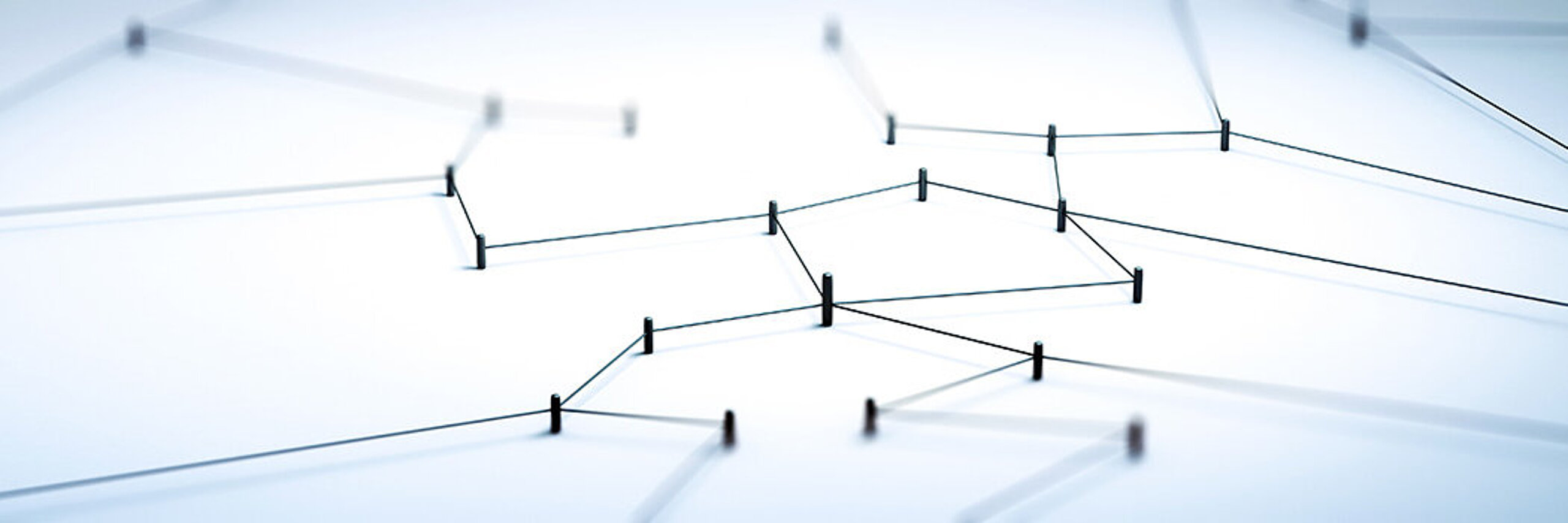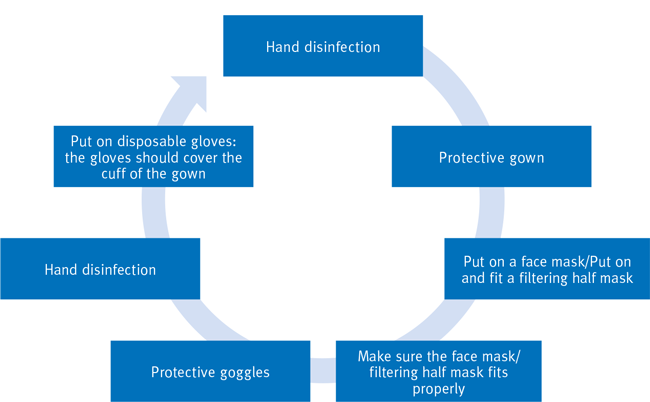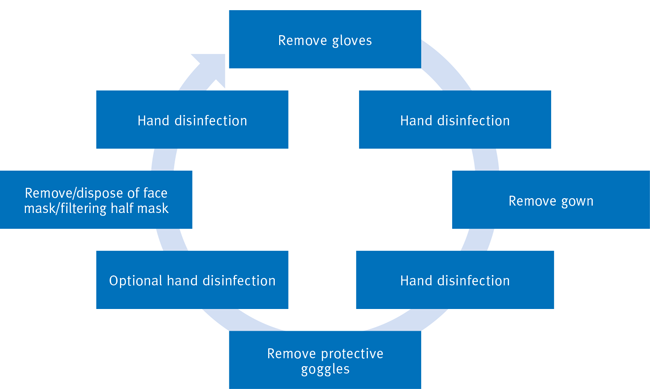Protective Clothing in Endoscopy
Putting on and taking off personal protective equipment (PPE)

In endoscopy, employees are constantly exposed to various potentially biohazardous materials. Personal protective equipment is crucial to staff protection and infection control. But how has the use of personal protective equipment (PPE) changed since the start of the pandemic?
Endoscopic examinations can lead to spray from secretions, excretions and aerosol formation. Therefore, reliable, adequate respiratory protection for staff must be ensured during examinations. This requires a risk analysis and a hazard assessment of the individual examinations. Endoscopy, Occupational Health & Safety, and Hygiene usually work together to prepare these.
This article is about PPE in the SARS-CoV-2 pandemic. It is intended to illustrate how to put on and take off PPE. Depending on the hazard assessments, the individual items of PPE in endoscopy are:
There is no set way of putting on and taking off protective clothing. The various expert associations for occupational health & safety and hygiene provide different guidance on how to put on and take off PPE in a low-contamination manner. The various workplaces should define a concept for their facility after reading the recommendations, and constantly train employees on the procedure for putting on and taking off PPE. Staff must feel confident in handling PPE in order to prevent contamination and transmission.
The diagrams provided show a way of putting on and taking off PPE according to the US Centers for Disease Control and Prevention (CDC).

Fig.: Putting on PPE
The protective gown should have long sleeves and be impervious to liquids and germs. Make sure that it reaches as far as the knees and completely covers the wrists.
The face mask protects against the spraying of blood, bodily fluids, secretions and excretions. When putting on the face mask, make sure it fits your face properly. To check this, make a triangle with your two index fingers. Now place this triangle against your face so that the apex touches the bridge of your nose and press the nose clip onto your nose and under your eyes. If air escapes, adjust the position of the face mask. Make sure that your nose and chin are completely covered.
The filtering half mask protects against the transmission of aerosols (SARS-CoV-2). Disinfect your hands, then remove the mask from the packaging. Fully unfold the mask without touching the inside of the mask. With one hand, put the mask over your mouth and nose, starting from your chin. With the other hand, pull the straps over your head. Now position the top strap above your ears and the bottom one on your neck. Make sure that the straps are lying flat and are not twisted. You can now optimise the position of the mask. Make sure that the mask fits tightly around your chin. With one hand (index finger and thumb), press the nose clip gently against the bridge of your nose. With the other hand, adjust the nose clip to the shape of your face. To check the fit, make a triangle with your two index fingers.
Now place this triangle against your face so that the apex touches the bridge of your nose and press the nose clip onto your nose and under your eyes. If air escapes, adjust the position of the mask. When performing activities (e.g. extubation, the drainage phase in bronchoscopy) in which aerosols containing pathogens are likely, protective goggles that also cover the sides of the eyes must be worn.
Disposable gloves must be worn if contact with material that contains pathogens is expected. When using disposable gloves, make sure that they completely surround the cuff of the gown. The outer surfaces of the gloves are usually heavily contaminated. Therefore, the gloves should be removed first. With one hand, take hold of the contaminated glove on the outside and remove it. Put your ungloved hand into the other glove and remove it. Dispose of the gloves immediately and perform hand disinfection.

Fig.: Taking off PPE
The outer surfaces of the gloves are usually heavily contaminated. Therefore, the gloves should be removed first. With one hand, take hold of the contaminated glove on the outside and remove it. Put your ungloved hand into the other glove and remove it. Dispose of the gloves immediately and perform hand disinfection.
Take hold of the gown at the neck from the outside and pull it forwards and open. Then open the centre strap at the torso. Take your arms out of the gown first. Next, fold/roll up the gown with the contaminated side facing inwards and dispose of it.
To take off the protective goggles, lean forwards slightly and close your eyes. Take hold of the two side supports of the protective goggles and pull them forwards away from the face. Then take off the protective goggles and wipe them with disinfectant later.
To take off the mask, lean forwards slightly and close your eyes. Slowly pull the bottom strap over your head. The bottom strap must not touch your face or eyes or the body of the mask. With one hand, hold the bottom strap at a distance from the mask. With the other hand, slowly pull the top strap over your head and bring the mask forwards and down. Then dispose of the mask and disinfect your hands afterwards.
| Items of personal protective equipment (PPE) | Performance requirements and testing procedures |
| Face coverings/respiratory protection; medical face masks | DIN EN 14683:2019+AC:201911 |
| Respiratory protective devices, filtering half masks to protect against particles | DIN EN 149:2001+A1:2009 |
| Protective gowns; protective clothing | DIN EN 14126:2003 |
| Protective gloves against dangerous chemicals and micro-organisms – Part 1 | DIN EN ISO 374-1:2018-10 |
| Medical gloves for single use – Part 1 | DIN EN 455-1:2020-07 |
| Protective goggles, personal eye protection | DIN EN 166:2001 |
PPE has always had to be worn in the various examination methods in endoscopy. When a pandemic is in full swing, it becomes clear that regular training on handling PPE, and wearing filtering masks in particular, is essential. This is the only way to ensure adequate protection of staff and infection control for patients during a pandemic. Training is required in order to ensure that filtering masks are put on and removed correctly and made to fit properly. The masks often slip out of place during the examinations. This is not always due to the mask models: incorrect use can also be to blame.
The wide range of recommendations on putting on and taking off PPE shows the importance of a uniform concept for employees in endoscopy with associated training. Further details and potential ways of putting on and taking off protective clothing can be found on the website of the German Society of Endoscopy Nurses and Associates (DEGEA) and elsewhere.

Heidrun Groten-Schweitzer is an Infection Control Nurse (ICN) at the UKE (Universitätsklinikum Eppendorf [University Hospital Eppendorf in Hamburg]). She has been working in the hygiene sector for many years, focusing on the reprocessing of medical devices, inspection of healthcare facilities, building hygiene and prevention of infectious diseases. Alongside her training role, she is chairwoman of the Department for Hygiene in Outpatient and Inpatient Nursing and Geriatric Care/Rehabilitation at the German Society for Hospital Hygiene.
1 | Krankenhaushygiene up2date2019;14 (2):227-240: Personal protective equipment from a hospital hygiene perspective – an update